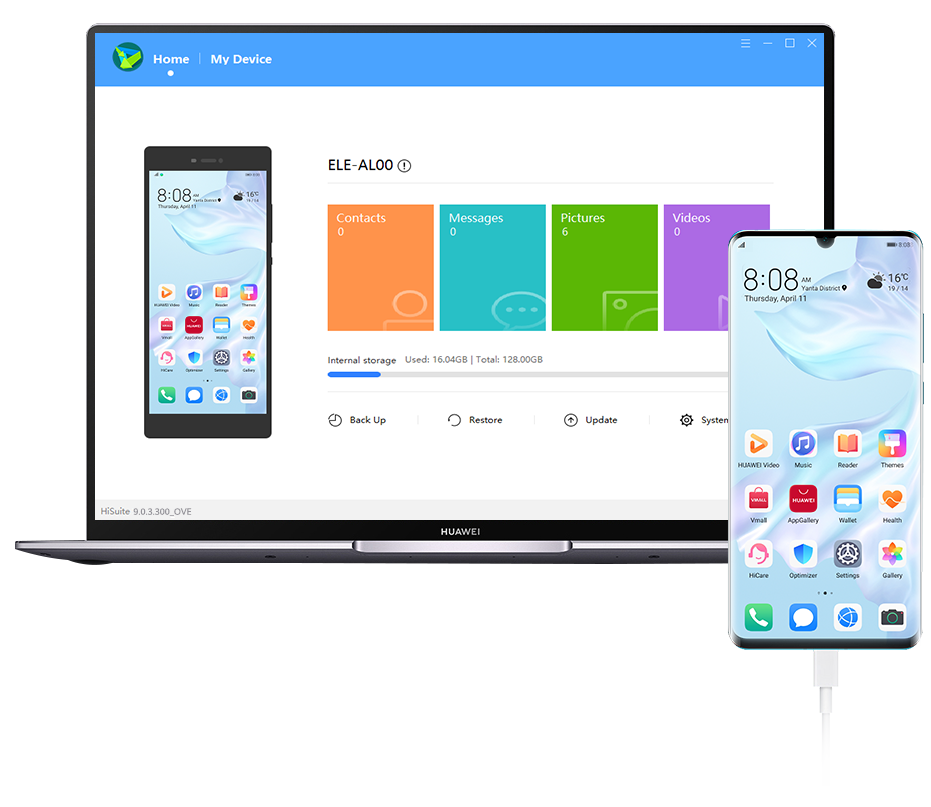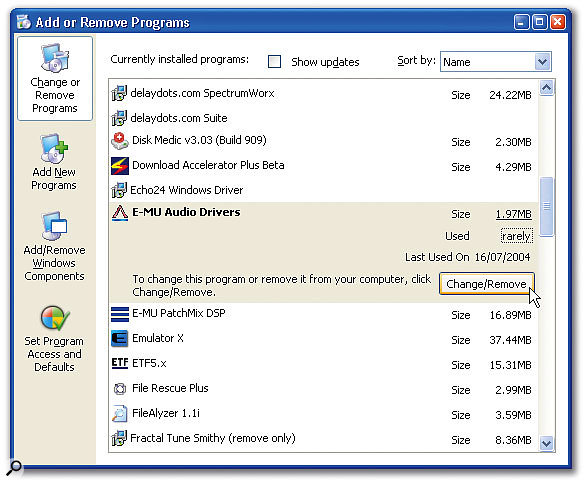Various software packages enable the stereo sound card found in a personal computer (PC) to provide oscilloscope-like displays, but the low-sample-rate, high-resolution analog-to-digital converters (ADCs) and ac-coupled front end are optimized for 20 kHz or less of usable bandwidth. This limited bandwidth can be extended—for repetitive waveforms—by using a sampling front end ahead of the sound card inputs. Subsampling the input waveform with a high-speed sample-and-hold amplifier (SHA)—followed by a low-pass filter to reconstruct and smooth the waveform—effectively stretches the time axis, allowing the PC to be used as a high-speed sampling oscilloscope. This article describes a front end and probe that provide an appropriate adaptation.
Figure 1 shows a schematic for a plug-in attachment that can be used for sampling with typical PC sound cards. It uses one AD783 high-speed sample-and-hold amplifier per oscilloscope channel. The sampling signal for the SHA is provided by the digital output of a clock-divider circuit; an example of one will be described. The AD783 input is buffered by a FET, so simple ac/dc input coupling can be used. In the two channels shown, 1-MΩ resistors (R1 and R3) provide dc bias when the dc-coupling jumper is open and the input is ac-coupled. The sampled output is low-pass filtered by the two-pole active RC networks shown. The filter need not be an active circuit, but the one shown usefully provides a buffered low impedance to drive the PC sound-card input.
The AD783 SHA provides a usable large-signal bandwidth up to a few megahertz. The effective slew rate at the input is above 100 V/µs. Input/output swing with a ±5-V supply is at least ±3 V. The small-signal 3-dB bandwidth for swings less than 500 mV p-p is close to 50 MHz.


- DOWNLOAD DRIVE MEDIATEK 7; sy-p8 sound card; AUDIMAX DUAL; AP-5.1 Driver for Windows download; AST110DVD MOBILE AUDIO; mediatek audio; dddd@shenzhen.net.cn loc:PL; driver for sound card audimax 5.1 usb; smart c208 driver free download; media tek opinie; octane mediatek 5.1.
- The package provides the installation files for AMD High Definition Audio Device Driver version 10.0.0.3. If the driver is already installed on your system, updating (overwrite-installing) may fix various issues, add new functions, or just upgrade to the available version.
With the front-end circuit of Figure 1, and a PC’s sound card employing the Visual Analyser1 software, the screen shot in Figure 2 illustrates a 2-MHz, single-cycle sine repeated at 1 MHz. The sampling clock provides 250-ns-wide sample pulses at an 80.321-kHz sample rate. The effective horizontal time base here is 333 ns/division. The PC sound card used in these examples uses an Analog Devices SoundMax® codec sampling at 96 kSPS. In this example, the effective sampling rate is about 40 MSPS.
Download C-Media PCI Audio Device for Windows to mEDIA driver. This package supports the following driver models: C-Media PCI Audio Device; Full Specifications.
Another screen shot was taken of a Gaussian sine pulse with a 1-MHz repetition rate (Figure 3). The sampling clock rate was again 80.321 kHz, with 250-ns sample pulse width.
Example of a Sampling Clock Generator
The AD783 requires a narrow positive sampling pulse with a width between 150 ns and 250 ns. The sampling pulse must be very stable with low jitter in order for the displayed waveform to be stable without jumping back and forth. This requirement tends to limit possible clock choices to crystal-based oscillators. Another requirement is that the sampling rate be adjustable or tunable over a range from slightly less than 100 kHz to about 500 kHz. The tuning steps between sampling frequencies need to be relatively fine for downsampled signals to fall somewhere within the 20 Hz to 20 kHz audio bandwidth of the sound card. A divide-by-N circuit, such as that shown in Figure 4, and a crystal oscillator with a frequency between 10 MHz and 20 MHz (IC4), can provide up to 200 or more different sample rates from 80 kHz to 350 kHz, with step sizes from 300 Hz to 5 kHz. In this example, using two 74HC191 4-bit binary up/down counters, N can be any integer between 4 and 256. Alternatively, decade counters, such as the 74HC190, with identical pinouts to the 74HC191, could be used to provide a range of N from 4 to 100. The division ratio is set using the two hex switches, S1 and S2. Switch S3 sets the counters to count up or count down. Resistor R1 (250 Ω) and Capacitor C1 (68 pF) add a slight delay to the terminal count output before it asynchronously loads the start-count values. The four NAND gates of the 74HC00 are used to implement a one shot that makes a 200 ns sample pulse when R12 is 2.7 kΩ and C2 is 68 pF.
IC4 is a fixed-frequency metal-can crystal oscillator. Another approach would be to use CMOS inverters (74HC04) and a discrete crystal, X1, to form an oscillator, as shown in Figure 5. This approach, while using more components than the all-in-one metal-can oscillator, permits a small amount of frequency tuning by adjusting Capacitor C1 to pull the crystal frequency.
To avoid the mechanically variable component, use a varactor diode—which has voltage-dependent capacitance—for D1, as shown in Figure 6.
Examples of Active Reconstruction Filters
Figure 7 and Figure 8 show active filter designs that should work well in place of a simple passive RC filter. Figure 7 shows a second-order Sallen-Key filter, with a corner frequency of about 39 kHz, using standard resistance and capacitance values. The AD8042 and AD822 dual op amps, specified for low supply voltage and wide swing, are good choices. The filter has a gain of +1 in the pass band.
Figure 8 shows another second-order multiple-feedback (MFB) filter with a corner frequency of about 33 kHz, using standard resistance and capacitance values. This filter has a pass-band gain of –1, so—if it is used—select the invert button on the scope software in order for the displayed waveform to be right-side up.
Powering the Circuits
The AD783 and the amplifier used in the reconstruction filter require dual power supplies. These could be provided simply by six AA batteries, with three providing +4.5 V and the other three providing –4.5 V. Or, a single 9-V battery could be used, with a resistance divider providing a midsupply voltage as the ground—which would need to be buffered by an op amp to supply any ground currents required by the circuit; alternatively, an adjustable linear regulator could be used to produce a voltage of approximately 4.5 V with respect to the negative battery terminal for use as the ground reference.
Yet another option would be to use the +5 V provided by a spare PC or laptop USB port. The –5 V could be generated by a dc-to-dc voltage inverter, such as the Analog Devices ADM8829—in a surface-mount package—or the ICL7660 in a DIP from Intersil. Special care will be required to avoid interference from switching noise generated by the dc-to-dc voltage inverter.
Input Attenuators
The small-signal gain of the AD783 is much higher than its full swing bandwidth. By inserting a 10:1 resistive attenuator ahead of the sampler to limit the maximum signal swing, usable bandwidth well beyond 20 MHz is possible. Relatively low cost scope probes are available from companies such as Syscomp Electronic Design, Ltd.2 (Figure 9). At this writing:

- Oscilloscope probes (P6040) with 40-MHz bandwidth, 1×/10×switchable, cost $29.99 per pair from Syscomp Electronic Design.
- HobbyLab3 sells the 20-MHz 10:1 version oscilloscope probes (GT-P6020) for $19.50 per pair.
- Gabotronics.com4 sells both 100-MHz P2100 and 60-MHz P2060 generic probes for about $10.00 each.
Using the Probes
The P2100 100-MHz 10× probes, used to take the Soundcard5 screen shots in Figure 10, Figure 11, and Figure 12, can compensate for input capacitance in the range from 10 pF to 35 pF. This seems to be a sufficient adjustment range for the proposed circuit if the PC board wire lengths are kept as short as possible. With the 10× probe, the input looks like 10 MΩ and 18 pF and can support input voltages up to ±30 V.
To demonstrate the AD783 sample-and-hold input stage, the probe compensation was first adjusted using a 1-kHz flat-top square wave. The screen shots show the response for various signals with frequencies of 1 MHz and 50 MHz. The two screen shots in Figure 10 show one channel with a 1 MHz, 5-V p-p square wave (a), and a 50-MHz, 5-V p-p square wave (b). In each case, the sample clock was adjusted for a downsampled signal frequency of about 500 Hz, so that any sound-card response differences were eliminated. Thus, the effective time scale is 500 ns/division for the screen shot on the left and 10 ns/division for the screen shot on the right. The sound card input gain was set for the scope software to report a 1.072-V p-p amplitude for the 1-MHz input and a 762.2-mV p-p amplitude for the 50-MHz input. The ratio of 0.7622/1.072 is close to –3 dB. This measurement shows that the combination of the 100-MHz 10× probe and the AD783 has a 50-MHz, 3-dB bandwidth.
In Figure 11, the same 1-MHz (a) and 50-MHz signals (b) are applied to both channels. From these two overlaid screen shots of both channels, one can see that there is good gain-, offset-, and delay-matching between the two channels.
The final screen shot (Figure 12) is of a 375-kHz, 5-V p-p square wave (red trace) and a 1.5-MHz 42 ns wide 5-V p-p pulse (green trace). The horizontal scale is 333 ns/division. The AD783 sampler maintains the full 5-V swing, even for these narrow 42-ns wide pulses.
References
1Visual Analyser is a complete professional real-time software package that transforms a PC into a complete set of measurement instruments. No new hardware is necessary as it uses the PC’s sound card. http://www.sillanumsoft.org/.
2Syscomp Electronic Design, Ltd. http://www.syscompdesign.com.
3HobbyLab http://www.thehobbylab.com/.

4Gabotronics http://www.gabotronics.com/accesories-and-cables/view-all-products.htm.
Electronic-design Sound Cards App
5The PC-based Soundcard oscilloscope receives its data from the sound card with 44.1-kHz sampling rate and 16-bit resolution. Also available is WaveIO, a Soundcard Interface for LabView software. http://www.zeitnitz.de/Christian/scope_en.
